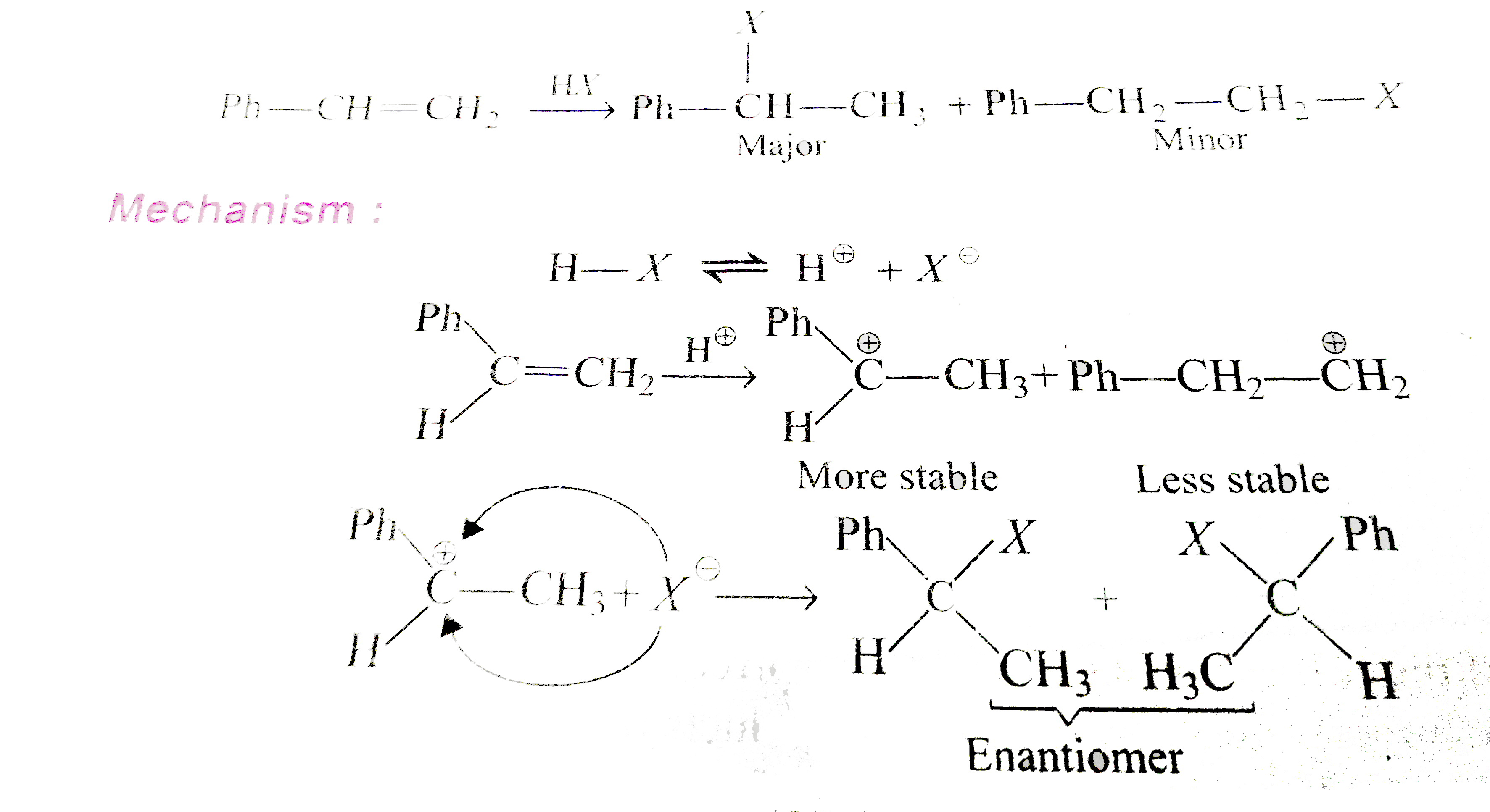Which of the following reaction is Anti-Markownikoff's addition ?
CH3CH=CH2+HBrperoxide−−−−→CH3CHBr−CH3
CH3CH=CH2+HBrperoxide−−−−→CH3CH2CH2Br
CH3CH=CH2+HClperoxide−−−−→CH3CH2CH2Cl
Both (B) and (C)
The correct Answer is:B
To determine which reaction represents an Anti-Markovnikov addition, we need to understand the concepts of Markovnikov's rule and Anti-Markovnikov's rule.
1. Understanding Markovnikov's Rule:
- When HX (where X is a halogen) is added to an alkene, the hydrogen atom (H) will attach to the carbon atom that has more hydrogen atoms already attached. The halogen (X) will attach to the carbon atom with fewer hydrogen atoms.
- Example: In propene (CH3-CH=CH2) + HBr, H will add to the CH2 group (more hydrogens), and Br will add to the CH (fewer hydrogens), resulting in 2-bromopropane.
2. Understanding Anti-Markovnikov's Rule:
- In the presence of peroxides, the addition of HX to alkenes follows the Anti-Markovnikov rule. This means that the hydrogen atom will attach to the carbon with fewer hydrogen atoms, and the halogen will attach to the carbon with more hydrogen atoms.
- Example: In propene (CH3-CH=CH2) + HBr (with peroxide), H will add to the CH2 group (fewer hydrogens), and Br will add to the CH (more hydrogens), resulting in 1-bromopropane.
3. Identifying the Reaction:
- We need to analyze the given reactions to see which one involves the addition of HX (specifically HBr) in the presence of peroxides, leading to an Anti-Markovnikov product.
- If the reaction involves HBr and a peroxide, it will likely follow the Anti-Markovnikov rule.
4. Evaluating Options:
- Option A: If it involves HBr with peroxide, it is likely Anti-Markovnikov.
- Option B: If it involves HBr with peroxide and results in 1-bromopropane, this is Anti-Markovnikov.
- Option C: If it involves HCl, it will follow Markovnikov's rule regardless of peroxide presence.
- Option D: If both B and C are mentioned, and since C does not follow Anti-Markovnikov, this option is incorrect.
5. Conclusion:
- The correct answer is Option B, which represents the Anti-Markovnikov addition.
- When HX (where X is a halogen) is added to an alkene, the hydrogen atom (H) will attach to the carbon atom that has more hydrogen atoms already attached. The halogen (X) will attach to the carbon atom with fewer hydrogen atoms.
- Example: In propene (CH3-CH=CH2) + HBr, H will add to the CH2 group (more hydrogens), and Br will add to the CH (fewer hydrogens), resulting in 2-bromopropane.
- In the presence of peroxides, the addition of HX to alkenes follows the Anti-Markovnikov rule. This means that the hydrogen atom will attach to the carbon with fewer hydrogen atoms, and the halogen will attach to the carbon with more hydrogen atoms.
- Example: In propene (CH3-CH=CH2) + HBr (with peroxide), H will add to the CH2 group (fewer hydrogens), and Br will add to the CH (more hydrogens), resulting in 1-bromopropane.
- We need to analyze the given reactions to see which one involves the addition of HX (specifically HBr) in the presence of peroxides, leading to an Anti-Markovnikov product.
- If the reaction involves HBr and a peroxide, it will likely follow the Anti-Markovnikov rule.
- Option A: If it involves HBr with peroxide, it is likely Anti-Markovnikov.
- Option B: If it involves HBr with peroxide and results in 1-bromopropane, this is Anti-Markovnikov.
- Option C: If it involves HCl, it will follow Markovnikov's rule regardless of peroxide presence.
- Option D: If both B and C are mentioned, and since C does not follow Anti-Markovnikov, this option is incorrect.
- The correct answer is Option B, which represents the Anti-Markovnikov addition.
Topper's Solved these Questions
- HALOGEN DERIVATIVES OF ALKANES AND ARENESBOOK - TARGET PUBLICATIONCHAPTER - HALOGEN DERIVATIVES OF ALKANES AND ARENESEXERCISE - CRITICAL THINKING
76 Videos
- HALOGEN DERIVATIVES OF ALKANES AND ARENESBOOK - TARGET PUBLICATIONCHAPTER - HALOGEN DERIVATIVES OF ALKANES AND ARENESEXERCISE - COMPETITIVE THINKING
81 Videos
- GENERAL PRINCIPLES AND PROCESSES OF ISOLATION OF ELEMENTSBOOK - TARGET PUBLICATIONCHAPTER - GENERAL PRINCIPLES AND PROCESSES OF ISOLATION OF ELEMENTSEXERCISE - Evaluation Thinking
15 Videos
- MODEL QUESTION PAPERBOOK - TARGET PUBLICATIONCHAPTER - MODEL QUESTION PAPEREXERCISE - MODEL QUESTION PAPER-II
47 Videos
Similar Questions
Knowledge Check
In which of the following reactions Markownikoff's rule of addition reaction is followed
A B
B C
C D
D
Which of the following follows Anti-Markownikoff's addition ?
ACH3CH=CH2+HBrPeroxide−−−−−→CH3CHBr−CH3BCH3CH=CH2+HBrPeroxide−−−−−→CH3CH2CH2BrCCH3CH=CH2+HClPeroxide−−−−−→CH3CH2CH2ClDCH3CH=CH2+HIPeroxide−−−−−→CH3CHI−CH3In which of the following reaction, Markownikoff's rule is violated?
ACH3−O−CH=CH2HBr−−−−−→CCl4BCH3−NH−CH=CH2HBr−−−−−→CCl4CCH3−S−CH=CH2HBr−−−−−→CCl4DO2N−CH=CH2HBr−−−−−→CCl4
Addition of HX on alkene proceed through the formation of carbocation .This reaction is also kjnown as Markownikoff reaction.Accroding to Markownikoff's rule addition of electrophile occurs on theat crbon of alkene which have mor number of 'H' atom.

Which of the Following alkenes will give Markownikoff reaction?
View SolutionWhich among the following reaction involves nucleophilic addition followed by elimination of water ?
View SolutionWhich of the following is anti aromatic ?
View Solutionwhich alkene does not follow Anti-Markownikoff's addition rule
View SolutionThe peroxide effect in anti-Markownikoff's additon involves:
View Solution
